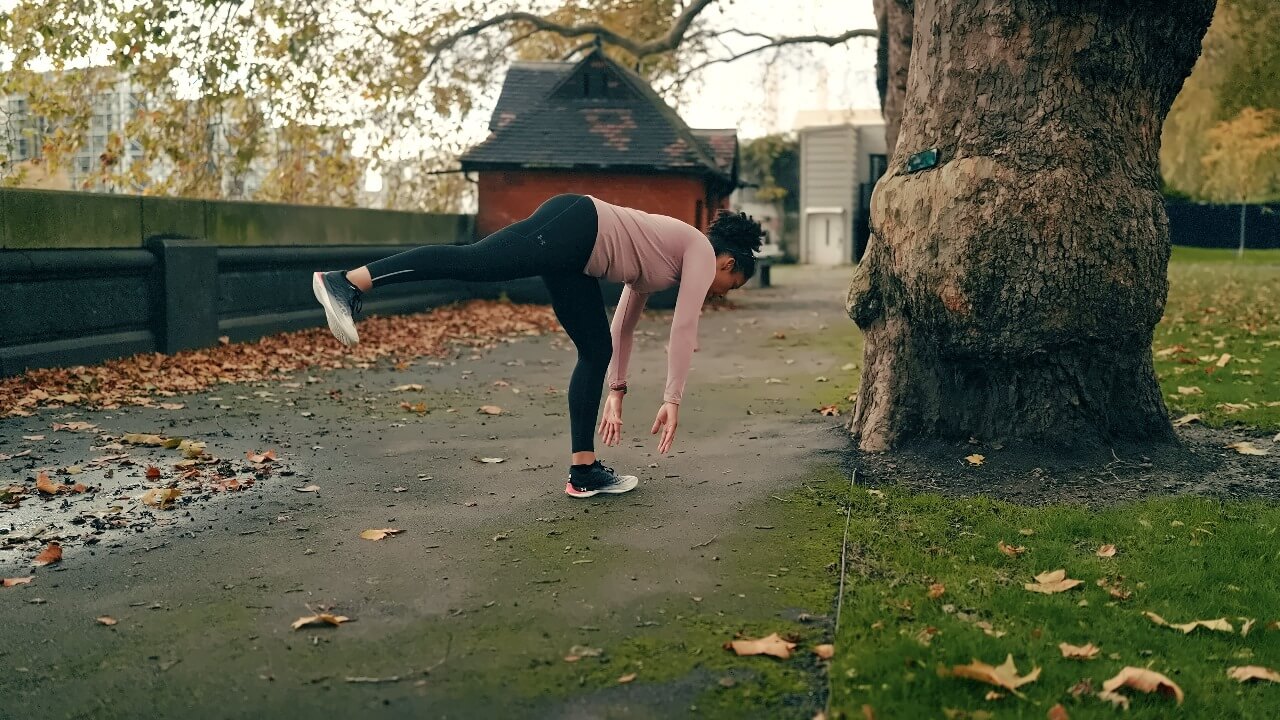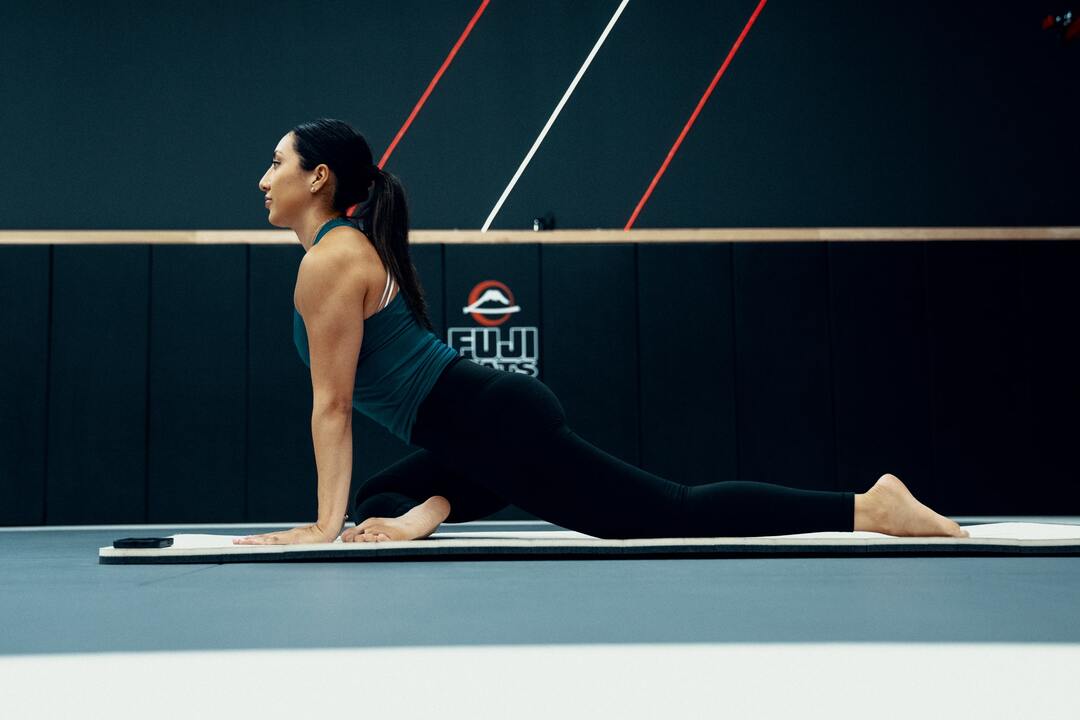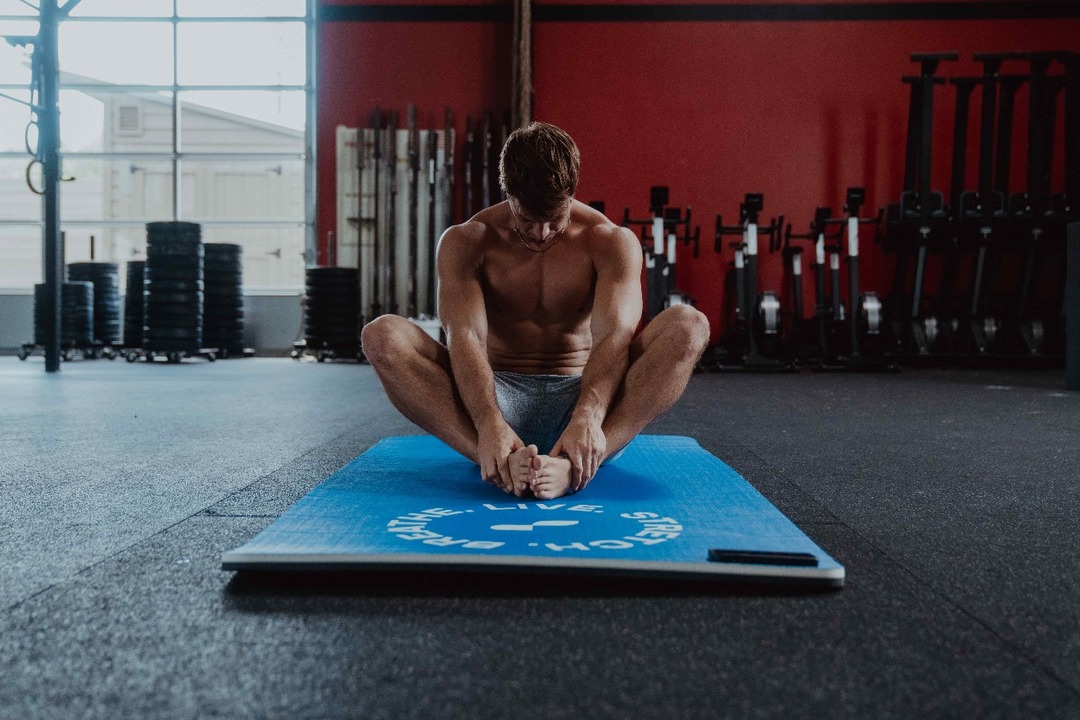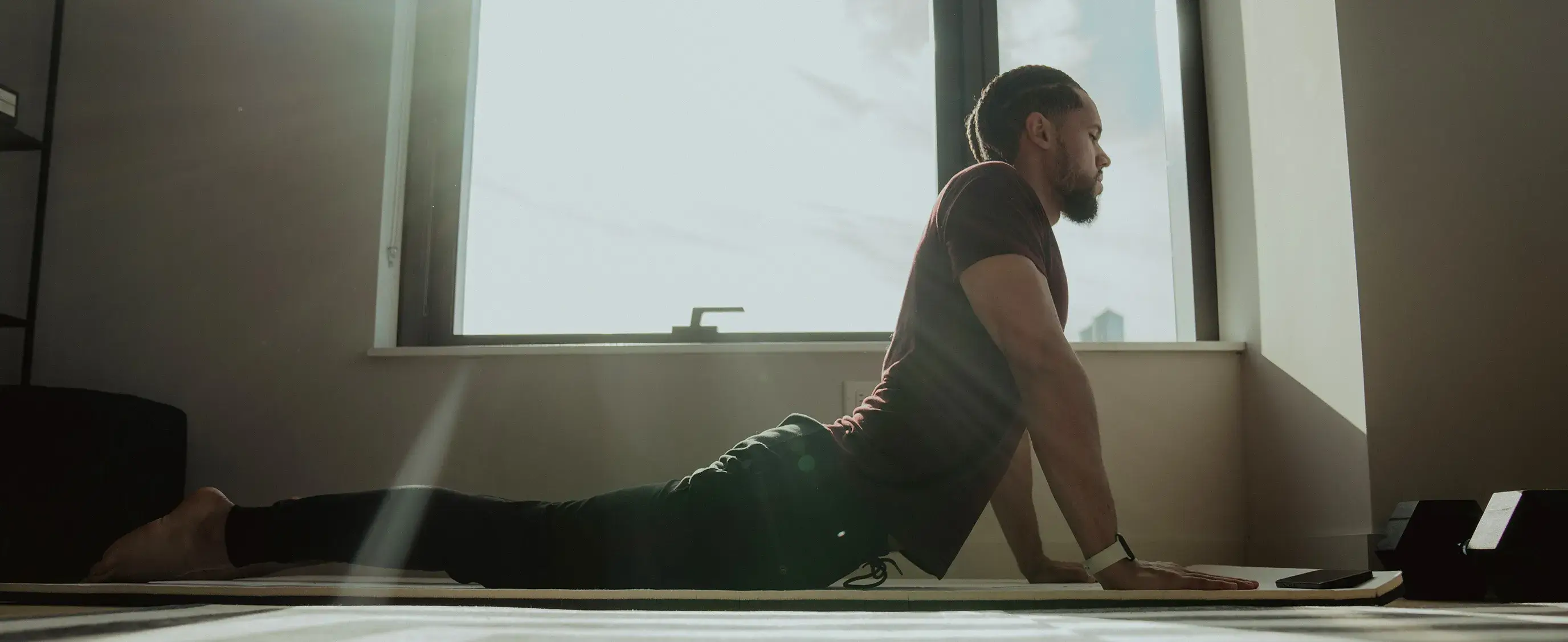Stiffness can be a drag. The body aches and feels heavy, and it’s tough to move comfortably, let alone perform athletic tasks or enjoy recreational activities. If this sounds familiar, you’re likely wondering how to become flexible if you are stiff. The good news is that you can improve your flexibility with the right approach. Incorporating regular flexibility exercises into your routine can help loosen tight muscles, enhance your range of motion, and make movement feel more natural. This guide will help you set clear goals and develop a plan that gradually increases your flexibility, reduces stiffness, and improves your performance and everyday mobility.
A mobility app like Pliability is a great way to start your flexibility journey. This tool provides targeted routines to help you recover and warm up and gives detailed insight into your progress.
How to Become Flexible if You Are Very Stiff
-min.jpeg)
Flexibility relies on several factors that differ from person to person. Understanding these causes can help determine why you lack flexibility and what to do.
Time and Temperature
Let’s look at the time of day. You may feel stiffer in the morning because your body has not yet warmed up. As you move around throughout the day, you might feel less stiff. Temperature plays a role in flexibility, as warmer temperatures promote increased blood flow and circulation, allowing for more significant movement.
Lifestyle and Flexibility
Lifestyle impacts flexibility. Sitting at a desk all day, your body will adapt to that lifestyle. If you take the time to stretch, you may regain some flexibility, but your body will remain accustomed to that position until you change it. If you’re a dancer, your body will be molded accordingly. The good news is that it's never too late when you decide to change your body.
Of course, you cannot control certain factors such as age, past injuries, or genetics, so you must focus on the factors you can change to reach your goals.
The Importance of Flexibility
We all know that being flexible is desirable, but why? Have we ever really established the many ways being flexible benefits our lives? Is it beneficial because it would be cool to touch your toes or do the splits, or is there more to it? Why is flexibility so important?
Here are a few reasons:
- Allows greater freedom of movement.
- Improves posture.
- Increases physical and mental relaxation.
- Releases muscle tension and soreness.
- Reduces the risk of injury.
- Keeps the muscle fascia lubricated so the muscle won’t be so compressed.
- Reduces the risk of age-related disorders (e.g. arthritis).
But to obtain the full benefits of flexibility, you need consistency. Stretching once a month isn’t going to get you results. That is why, to reach your goals, you need to have a system in place to actively work towards becoming more flexible.
What to Do If You are Extremely Inflexible
If you consider yourself highly inflexible, the first thing you should do is not beat yourself up and applaud yourself for looking into becoming more flexible. You’re taking the first step towards bettering yourself, which means a lot.
So what is the first step? Here are a few suggestions I can offer:
- Commit to practicing 2-3 times/week: Try to start with 15 minutes and gradually build up to 45 minutes. Regarding flexibility, you need to give your body time to warm up, so the longer you practice, the more progress you will see.
- Warm up before you practice: If you notice you feel stiff while practicing yoga, you probably need to warm up more. 5-10 minutes of walking, rowing, and jogging, should do the trick. We also have a simple seated warm-up you can use.
- Drink more water: Water plays a vital role in lubricating your joints. Also, if you’re dehydrated, your muscles are dehydrated, which leads to stiffness.
- Try to focus on your flexibility training later in the day: As stated earlier, the time of day you practice yoga affects your flexibility. If you’re practicing right after you wake up, you’ll have to warm up way longer than if you practiced later in the day after moving around a bit more, and your body is naturally a bit warmer.
- Focus on the proper stretches: To see results, you must focus on movements that will help you move forward. You can practice many different yoga and stretching routines, but to progress, you want to make sure you are doing flexibility-focused exercises.
If you stretch, find a position to sit and comfortably watch TV. If your muscles work hard to hold you up or keep you balanced while opening those hamstrings, your body can remain strained and inflexible.
If things are going to open up, your brain needs to believe everything is safe and easygoing, so put yourself in a position where you'd be happy sitting and watching TV for a while.
Modifying Poses for Accessibility
Take a runner's lunge, for example. If you're having a tough time balancing with your hands on the ground, or it's hard for me to sit on your back heel, find another way! Just sit down on the ground, left heel tucked in like I'm sitting cross-legged, and extend your right leg straight. Now, lean back with your hands behind you. Get comfortable. You have a good starting point once you're happy where you are.
Try moving around gently rather than holding yourself in your "deepest stretch" and waiting for it to end. If I hang out at the end of your range of motion, I can risk micro-tearing your connective tissue. Instead, focus on active or dynamic stretching to become more flexible.
Exploring the Modified Lunge
Let's use the modified runner's lunge example again, where I sit down with one heel tucked in and one leg straight forward. Start by leaning back. Take a moment and get used to things here. Next, try walking your hands to the right and leaning into them, maybe even bringing a forearm down to the ground. Do the same thing on the left side.
Natural Movement and Breathing
Keep a slight bend in your knee and stay relaxed in your leg, so as you roll from right to left, your leg can roll around, too. Sometimes, your knee will face straight up, to the right, and sometimes to the left. That's OK! Let your body move naturally and do its own thing. If you find a good spot to linger and breathe, that's your spot. You linger and breathe as long as you like.
Remember to Breathe Deeply
It might not be evident initially, but if you want more flexibility, focus more on your breath than your muscles. Breathing can put your mind at ease and create the right conditions for your muscles to release tension.
Breath and Body Awareness
Breathe deeply enough that every inhale lifts me a little out of wherever I am, and every exhale eases me back wherever your body feels like going. When your body is relaxed, every breath can move me. If your breath isn't driving me, try scanning through your body, and see where I might be holding tension or working harder than needed. Let the stress go, and breathe deep. After all, as we mentioned, flexibility begins in the mind.
Avoid Extreme Positions
Bending over backward to put your head in your behind isn't likely to help me with much! A healthy body balances stability and mobility, strength and flexibility.
Hyper-mobility in joints is a common affliction of yogis and performance artists (think ballerinas and Cirque du Soleil artists). It can lead to reduced athletic capability and sometimes chronic pain. Instead, you want to reach your middle point, where your body works at its best: a nice balance between stability and mobility.
Drop the Goals, Get Into You
The problem with visible goals is there's a lot of temptation to force your way into them rather than finding your way there peacefully. I might reach the goal, but the outcome isn't so good or healthy.
Exploring Movement, Not Goals
Let's try again in the runner's lunge example: Rather than just aiming to touch your toes or get your head to your knee every time, forget the goal! There's so much more to you than just a pose; You can take many more directions than just straight ahead. So explore: Move gently in every imaginable direction around a forward fold. See what you find. It will be different every day, and you'll get to know more and more of yourself. It should be fun, not frustrating.
Move More, Rather Than Pose More
Take a standing forward bend as an example. Relax and move rather than try to get deeper into the bend! Put a little bend in your knees and sway gently. If you’re looking for more flexibility, the key is moving more.
You might lean so far off to the right that your left leg lengthens, and the foot might even leave the ground! Same thing on the other side. Focus on moving quickly and comfortably all around where you are. You can become more flexible and mobile simultaneously if you use this technique.
Focus on Your Stiffest Areas
How it works
Naturally, some joints feel more stiff than others. Areas that are stiff overcompensate, which prevents other muscles from being appropriately stretched. Pull the stiffest areas for 10-20 minutes daily to make the most of your routine. Once these muscles loosen up, it will be easier to stretch neighboring muscle groups.
Identifying Areas of Tension
To identify your stiff areas, ask yourself if you feel tension in any particular muscle group when performing day-to-day tasks (sitting, standing, squats, bending over) or places you find difficult to stretch. Common areas that store tension are:
- Neck
- Upper back
- Lower back
- Hip flexors
- Hamstrings
You can focus on stretching-related muscles if you aim to achieve a specific flexibility move, such as your:
- Downward-facing dog
- Forward fold
- Splits
Choose 3-4 stretches that target your stiffest areas. Stretch those muscles every day to increase your range of motion. Over time, you will notice improvements in surrounding muscles.
Set Small Targets to Measure Progress
How it works
Training for flexibility takes time and patience. It could take weeks or months to see any noticeable results. Pick smaller targets you can work towards each day to help you measure your progress and keep your goals in check. Taking progress videos at the end of each stretching session helps you:
- Work towards an end action
- Attempt the final stretched position
- You can feel a sense of accomplishment when you set up your webcam and see that you are more flexible than at the start of the stretching session.
- Pick your target. For example, you can take progress pictures after stretching or simply find a spot on the ground that you can reach. Whichever target you choose, take a moment to acknowledge your accomplishments as you continue with your daily practice. This will help you make little improvements each day.
Don’t Be Afraid to Make Modifications
How it works
Find a stretch variation where you feel mild discomfort. The idea is not to push to the point where you feel pain. Pushing too far too quickly increases the risk of muscle strain, hindering any progress you’ve made.
There are stretches for every level of flexibility, whether you’re a complete beginner, intermediate, or advanced. If you’re inflexible, start with modified stretches using yoga blocks. Practicing with yoga blocks allows you to focus on correcting your form. I work on form first for best results, and depth will improve naturally.
Related Reading
- Why Is Flexibility Important
- Does Flexibility Increase Speed
- Can Anyone Become Flexible
- Does Stretching Make You More Flexible
- Why Is Flexibility Important for Team Sports
- Increase Back Flexibility
- How Long Does It Take to Get Flexible
- Which Activity Is a Type of Flexibility Exercise?
- Sports That Require Flexibility
- What Is the Best Strategy to Improve Flexibility in Your Legs and Back
- Mobility vs Flexibility
- Sports That Require Flexibility
7 Beginner Yoga Poses to Increase Flexibility

1. Ragdoll: Unravel Tightness in Your Whole Body
Ragdoll is a great beginner pose that works the whole body to release tightness and tension. Remember to bend your knees as much as you need here and let your head hang loose. You’ll feel a nice stretch in your:
- Hips
- Hamstrings
- Neck
- Shoulders
- Back
Tip: Shake your head “yes” and “no” to gently relieve tension in your neck and shoulders. Also, gently shift your weight from your heels to the balls of your feet to relieve any tightness in different areas of your legs.
2. Easy Seated Side Stretch: Stretch Your Sides and Improve Posture
This pose works wonders for stretching your side-body and releasing shoulder and triceps tension. It is also very helpful in improving posture- a simple tip would be to sit on a blanket or bolster to help you easily sit up straight.
Tip: If you find it challenging to keep your fingers interlaced, try grabbing your wrist with your hand instead and gently pulling yourself in the opposite direction for a nice, deep stretch.
3. Half Happy Baby: Open Your Hips
This is a great pose to practice when opening your hips gently. If I know I will be focusing on hips in my practice, I love to start with Half Happy Baby to get a feel for where my body currently is about tightness.
Tip: Bending your knee will make the stretch in your other hip less intense. A strap can also help if you cannot reach your foot without straining your neck.
4. Camel Modification: Open Your Chest and Shoulders
This beginner-friendly version of Camel Pose is excellent for gently opening the chest and shoulders.
Tip: Another option is to do this by pressing the front of your body into a wall to help you stabilize.
5. Reclined Big Toe: Stretch Your Hamstrings
This is one of my favorite poses to practice when my hamstrings feel tight. The strap gives you much control over how deep of a stretch you want and allows you to focus solely on releasing tension in one leg at a time. Just remember not to lock your knee!
Tip: Practice doing little pulses (while keeping a micro-bend in the knee) while actively pressing your heel up towards the ceiling to get a deeper stretch.
6. Reclined Spinal Twist: Release Tension in Your Spine
Twists are great for practicing to release tension in the spine and improve flexibility. Ensure you actively press your opposite shoulder into the mat while you twist. Feel free to add a pillow or block under your leg for support.
Tip: If this is uncomfortable, try bending both knees and twisting to make it less intense.
7. Calf Stretch: Target Stiff Calf Muscles
Begin by kneeling on both knees. Bring your left leg in front of you and bend it. Extend your right leg behind you. Rest your arms on your bent leg and shift your body weight slightly. Maximally stretch out your calf muscles by moving your left knee forward over the middle of your left foot.
Press the ball of your left foot into the ground as you feel your calf muscles tighten. Hold the contraction for 10 to 20 seconds. Relax between reps, trying to get deeper in the stretch each time. Repeat this 3 to 4 times. Repeat on the other side.
Related Reading
- Why Is It Important for Athletes to Be Flexible
- Flexibility Sports Examples
- How Many Days Per Week Can You Perform Flexibility Exercises?
- Flexibility Exercises for Kids
- Flexibility Exercises at Home
- How Can Flexibility Training Reduce the Risk of Back Pain?
- Flexibility Exercises for Beginners
- How Frequently Should Flexibility Exercises Be Performed for Best Results?
- Benefits of Flexibility
- Flexibility Workout Plan
- Types of Flexibility Exercises
- Back Stretches for Flexibility
- Strength and Flexibility Training
- Exercises for Lower Back Pain
- How to Stretch Quads
- Morning Stretch
- Best Quad Stretches
- At What Average Age Does Flexibility Start to Diminish for Most People?
- IT Band Stretches
- IT Band Stretch
- IT Band Exercises
- Inner Thigh Stretches
- Cool Down Stretches
- Standing Quad Stretch
Improve Your Flexibility with Our Mobility App Today | Get 7 Days for Free on Any Platform
Pliability offers a fresh take on yoga tailored for performance-oriented individuals and athletes. Key features include:
- A vast library of high-quality videos designed to improve flexibility, aid recovery, reduce pain, and enhance range of motion.
- Daily updated custom mobility programs for optimizing their health and fitness.
- A unique body-scanning feature to pinpoint mobility issues.
Enhancing Movement
Whether you're limited by pain or movement restrictions, Pliability complements your fitness routine and helps you move better.
Sign up today for a 7-day free trial on iPhone, iPad, Android, or via our website to improve flexibility, aid recovery, reduce pain, and enhance range of motion with our mobility app.
Related Reading
- Leg Flexibility Exercises
- Muscular Flexibility Exercises
- Pliability vs Flexibility
- Flexibility Workout
- Flexibility Routine
- Best Stretches for Flexibility
- Best Flexibility Apps
- StretchIt vs Pliability
- Bend vs Stretchit
- Bend App Alternative
- Band Stretches
- Side Stretches
- Stretches for Sore Legs





.jpg)


